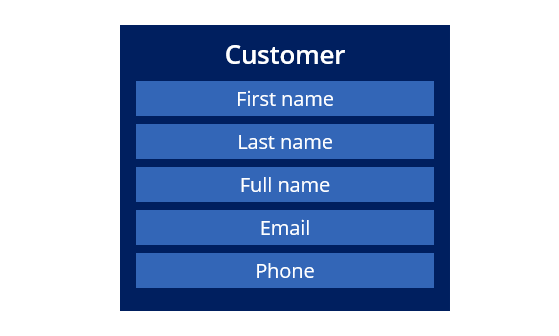
Understanding data objects
One of the most important tasks Pega Business Architects perform is identifying the data that is required for successful Case resolution. In Pega Platform™, the data entities, and the attributes that define them, are created as data objects.
In this topic, you examine how applications use data objects to collect related Case data.
Data objects
A data object is a structure for describing a data entity by grouping a set of related fields. For example, a supermarket Online orders application might contain an Customer data object. As seen in the following image, the Customer data object includes fields that describe the supermarket's customer, such as First name, Last name, Full name, Email, and Phone.
Data objects hold data for your application and simplify the organization of fields, user interface views, and integration settings that your application needs to access the right data at the right time to successfully resolve a Case.
Each data object is reusable across an application's Case Types, saving development effort as well as ensuring data consistency.
Structure of a data object
Each data object is made up of a collection of fields. Each field has a name and a Field Type, and is used to capture and present data as needed in an application. Collectively, the different fields define the structure of the data object.
You can extend the structure of a data object by referencing other data objects. When one data object references a second data object, the fields in the second data object become part of the referencing data object. Any data object can be referenced either once or multiple times, depending on the need.
Data objects and the Case Life Cycle
Data objects are created in App Studio's Integration Designer landing page. Once a data object is created, it is identified in the Case Life Cycle, allowing the workflow to access the related data throughout the Life Cycle of the Case.
The instance of the data object can be called in one or more Steps throughout the Case Type. The fields used to facilitate Case resolution can vary between Steps, so that users focus only on data relevant to each Assignment. For example, in the supermarket's Online order Case Type, the Identify customer Step references the only the customer's First name, Last name, Email, and Phone fields, while the Order review Step references only the Full name and Email fields. Because the same Customer data object is referenced in both steps, you are assured the information is related to the same customer.
Sourcing data objects
You can source the data for data objects locally from the Pega database where Data Records are stored within tables, or you can source the data from an external systems of record, such as an inventory or HR database or streamed directly from another source, that your client organization already maintains.
Data objects in Dev Studio
In Pega, the names data object and field are specific to App Studio. In Dev Studio, the technical implementation of the structure are referred to as data type and property. Despite the difference in naming, the structure and information associated with a Customer data object in App Studio is the same for the Customer data type in Dev Studio.
Note: In Dev Studio, developers work directly with the underlying data type and properties, not with the data object and fields. As a result, you may find the terms data object and data type, as well as fields and properties used interchangeably on projects and documentation.
Creating data objects
Pega Platform comes pre-configured with a selection of commonly-used data objects such as Address-Postal and Address-Email. Work with your LSA to determine if any of Pega's pre-configured data objects are suitable for use in your application.
If a suitable data object does not exist yet, create a new one. For example, if you want to add the Airport Codes data object, but you cannot use or extend an existing data object, create a new one in Pega Platform.
New data objects can be configured using App Studio's Integration designer landing page.
It is also possible to create a new data object directly in the Case Life Cycle designer for a Case Type. When a new data object is created in the Data & Interfaces section of Case Life Cycle designer, Pega Platform creates the Draft version of data object object in the Integration designer. A Draft version of the data object does not have fields or integration settings. Rather a draft data objects acts like a placeholder, allowing the business to identify how and when data is used in the Case Life Cycle, which may influence the eventual design of the data object. Draft data objects must eventually be configured with fields and integration settings in either App Studio's Integration designer or Dev Studio to provide data to an application.
Check your knowledge with the following interaction:
This Topic is available in the following Module:
If you are having problems with your training, please review the Pega Academy Support FAQs.
Want to help us improve this content?
